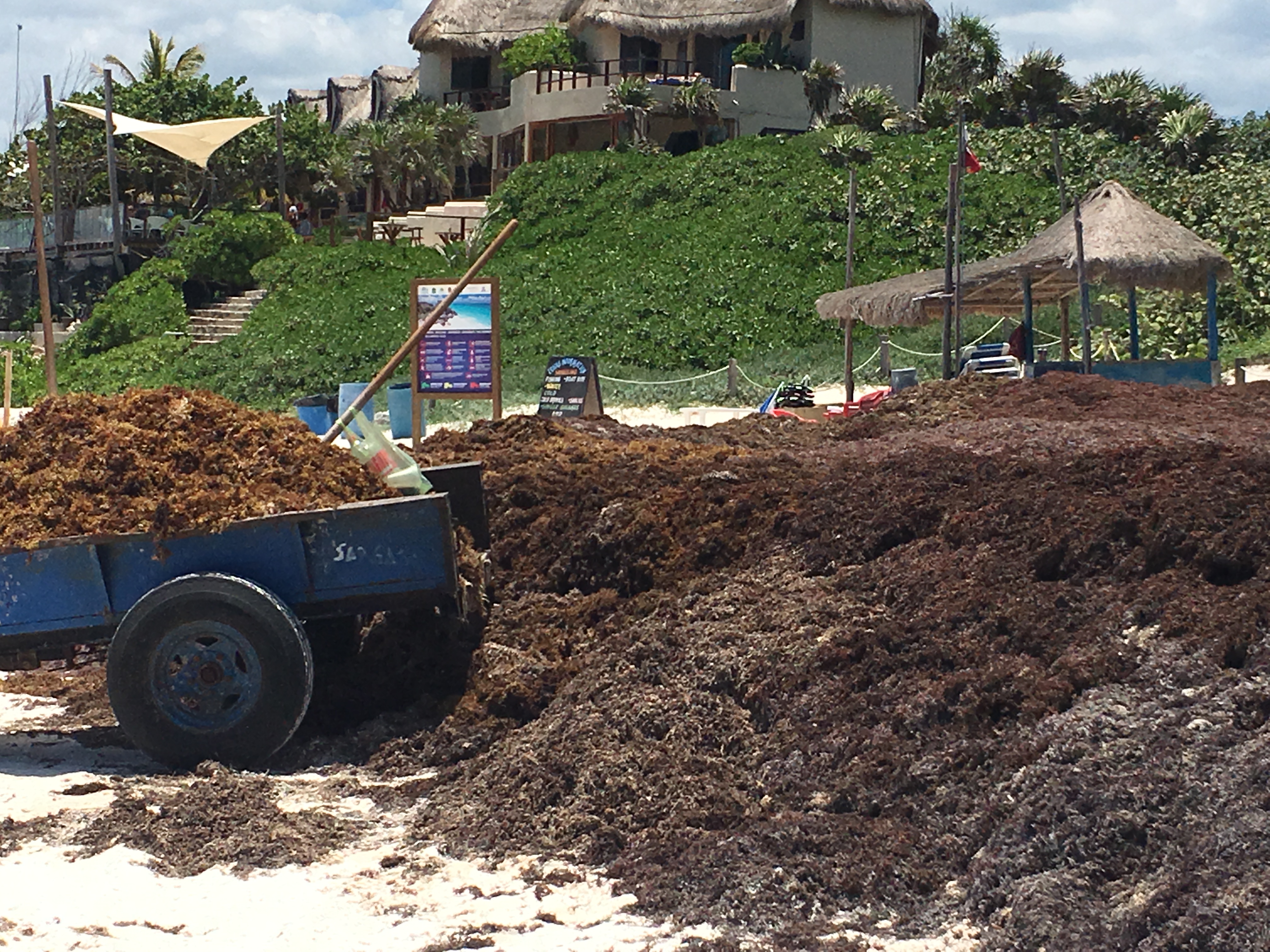Sargassum Seaweed is Strangling the Caribbean Coasts, the Latest Example of Climate Chaos

Sargassum is sometimes referred to as a “golden floating rainforest”, which seems like an inappropriate moniker at the moment. As rainforests are decimated at an alarming rate this “rainforest” may be the only one that is blooming out of control. Classified as a brown alga, the mountains of sargasso now appearing across the beaches of the Caribbean are creating impacts that go much deeper than just tourism.
Sargasso is not uncommon in these regions: most every winter Sargassum fluitans and Sargassum natans can be found floating and drifting along most Caribbean coastlines. However, over the past few decades these self-propagating blooms have been gaining a significant stronghold, creating a slew of negative consequences. They form putrid barriers along the coastline, preventing access to the Caribbean Sea, and as decomposition sets in the noxious smell becomes overwhelming and harmful. By some reports, levels of hydrogen sulfide emitted from these decomposing algal mounds are even enough to cause detriments to human health.
The U.S. Occupational Safety and Health Administration have reported that prolonged exposure to hydrogen sulfide can cause symptoms of nausea, tearing of the eyes, loss of sleep, and respiratory problems. Two parts per million (PPM) of hydrogen sulfide can cause spontaneous abortion and 100 PPM is potentially deadly. The biological opinions of a scientific report conducted in 2015 in Martinique by ANSES (the French agency for food, environmental and occupational health and safety) has recommended limited exposure to the public.
However, these recommendations are not standardized and as piles appear along pristine coastlines local workers and beach goers remain relatively unaware of potentially harmful effects of the decomposing algal matter. Workers who painstakingly shovel piles of putrefying sargasso in attempts at removal are often not uniformly informed, protected, or appropriately compensated for their hazardous labor.
Another primary concern is the negative effects on marine life, especially turtle nesting grounds. Already a sensitive conservation issue due to overdevelopment along coastlines, turtle populations are now at greater risk, with adult turtles and hatchlings becoming trapped within the algal mounds. Hatchlings are having difficulties crossing over mountains of sargasso, a summiting event that for a juvenile turtle resembles something along the scale of Mount Kilimanjaro. An already arduous journey for hatchlings has now become even more of a biological miracle.
Several strong premises for the increasingly abundant and spreading mats of algal bloom exist within the scientific community. Well researched hypotheses include: climatic changes, deforestation particularly in the Amazon basin, an increased oceanic uptake of Sahara Desert dust from desertification and a decrease in cyclonic activity in the Caribbean region during the last decade. As with most biological anomalies it is possible that all of these factors are contributing to the sargasso dilemma. However, many researchers are finding that warming ocean temperatures and an increased nutrient oceanic uptake from deforestation and industrial agricultural practices that utilize synthetic fertilizers are likely the leading causes of algal overgrowth. This combination of warming oceans and an increase of plant loving nutrients creates a copacetic environment for algal blooms.
While the problem does remain serious enough that many Caribbean nations are declaring states of emergency and siphoning large amounts of financial resources to clean-up operations, appropriate solutions exist but remain underutilized. These operations often make use of heavy equipment, yet efforts should involve best practice techniques during removal avoiding use of heavy machinery which only causes greater impact to coastal marine life. Hand raking, while slow, can achieve results and allows for analysis and avoidance of marine creature nesting grounds. Once the sargasso has been raked it is often plastic bagged and shipped out into the jungle increasing decomposition time and reducing benefits of this nutritive biological resource.
The sequestration and removal of algae falls under the same constraints as all our waste. Where does our waste go? It is collected and seemingly goes away, out of sight, out of mind. Yet our waste holds value and, in the future, will likely be our most prominent resource. If we shift our perspective and treat waste as an opportunity, landfills transform into gold mines. Many countries already drowning in foreign waste from foreign powers have come to this forced realization
Sargasso blooms in moderation can provide a safe haven for marine life. One species of fish the Sargassum fish live strictly in this environment and these algal blooms are a bonafide playground for dolphins, mahi mahi, sailfish and jackfish. Prior to decay, sargasso poses no threat to human health and in fact is edible! Sargassum is even used in Chinese medicine to treat phlegm and goiters due to its high iodine content. These algal blooms do also serve important ecological functions, it is merely the excess that causes harm. As we now find ourselves in a perpetual case of environmental extremes we must find our way back to moderation.
Solutions exist that tackle the algal problem while simultaneously providing relief from the etiologies of most environmental problems. Reuse of algal overgrowth can help to decrease the primary causes of the problem itself; climatic changes, impacts of synthetic fertilizer, and deforestation. Algal blooms have been shown to be a great organic fertilizer. Any gardener would be happy to get their green thumbs on a load of sargassum. Farmers alike can feed livestock sargassum which contains a treasure trove of nutrients. Sargasso can also be harvested and transformed to produce alternative energy.
These solutions all help to weaken the chokehold of the strangling sargasso, decreasing the amount of carbon and methane emitted into the atmosphere, providing alternatives to synthetic fertilizers and acting as a substitute for timber, helping to keep trees where they belong, in the ground. All of these outcomes are catalysts to a whole slew of other global environmental problems. The symbiotic nature of our environment provides a perfect platform for contagious change. We continually view the world from an anthropocentric perspective, a shallow analysis that fails to take into account the depth of nature’s innate connections.
As Caribbean beaches are slowly becoming pristine paradises of the past, ecological caution and caretaking must become commonplace. While we search for solutions to our environmental quandaries, let’s make sure our problem-solving targets more than the superficial aspects of our issues. Resolutions capable of rejuvenating the whole exist within every issue, it is merely our approach that needs to be tweaked. By taking wholly sustainable approaches to ecological problems we can instil local change while simultaneously alleviating global problems.




Milledge, J.J.; Harvey, P. Golden Tides: Problem or Golden Opportunity? The Valorisation of Sargassum from Beach Inundations. Journal of Marine Science and Engineering 2016, 4, 60.
Abstract
In recent years there have been massive inundations of pelagic Sargassum known as golden-tides on the beaches of the Caribbean, Gulf of Mexico and West Africa causing considerable damage to the local economy and environment. Commercial exploration of this biomass for food, fuel and pharmaceutical products could fund clean-up and offset the economic impact of these Golden-tides. This paper reviews the potential uses and obstacles for exploitation of pelagic Sargassum.
Although, Sargassum has considerable potential as a source of biochemicals, feed, food, fertiliser and fuel, variable and undefined composition together with the possible presence of marine pollutants may make golden-tides unsuitable for food, nutraceuticals and pharmaceuticals and limit its use in feed and fertilisers.
Discontinuous and unreliable supply of Sargassum, also presents considerable challenges. Low cost methods of preservation such as solar drying and ensiling may address the problem of discontinuity. The use of processes that can handle a variety of biological and waste feedstocks in addition to Sargassum is a solution to unreliable supply, and anaerobic digestion for the production of biogas is one such process.
More research is need to characterise golden-tides and identify and develop commercial products and processes.